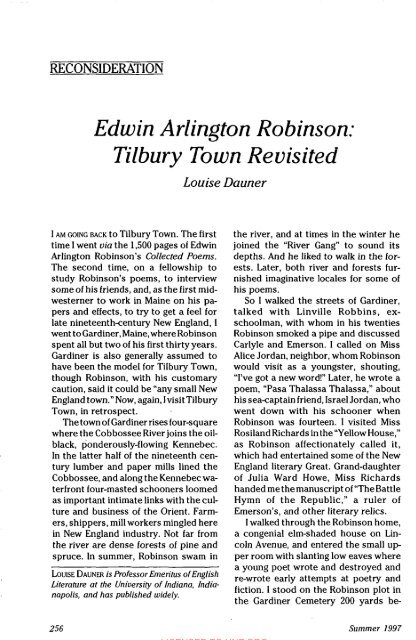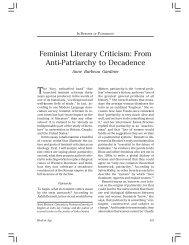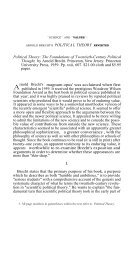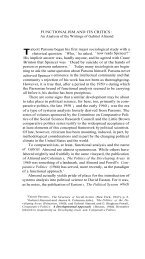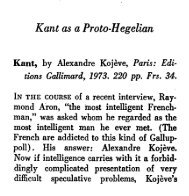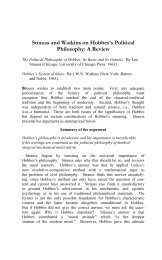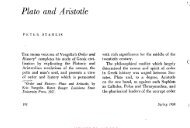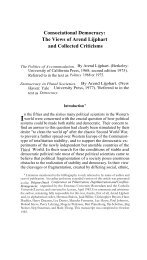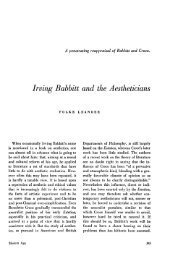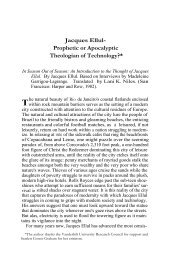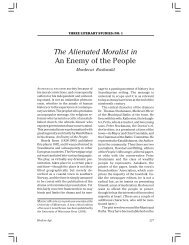Edwin Arlington Robinson: Tilbury Town Revisited
Edwin Arlington Robinson: Tilbury Town Revisited
Edwin Arlington Robinson: Tilbury Town Revisited
You also want an ePaper? Increase the reach of your titles
YUMPU automatically turns print PDFs into web optimized ePapers that Google loves.
RECONSIDERATION<br />
<strong>Edwin</strong> <strong>Arlington</strong> <strong>Robinson</strong>:<br />
<strong>Tilbury</strong> <strong>Town</strong> <strong>Revisited</strong><br />
I AM GOING BACK to <strong>Tilbury</strong> <strong>Town</strong>. The first<br />
time I went via the 1,500 pages of <strong>Edwin</strong><br />
<strong>Arlington</strong> <strong>Robinson</strong>’s Collected Poems.<br />
The second time, on a fellowship to<br />
study <strong>Robinson</strong>’s poems, to interview<br />
some of his friends, and, as the first mid-<br />
westerner to work in Maine on his pa-<br />
pers and effects, to try to get a feel for<br />
late nineteenthcentury New England, I<br />
went tocardiner, Maine, where<strong>Robinson</strong><br />
spent all but two of his first thirty years.<br />
Gardiner is also generally assumed to<br />
have been the model for TiIbury <strong>Town</strong>,<br />
though <strong>Robinson</strong>, with his customary<br />
caution, said it could be “any small New<br />
England town.” Now, again, Ivisit <strong>Tilbury</strong><br />
<strong>Town</strong>, in retrospect.<br />
The town of Gardiner rises four-square<br />
where the Cobbossee River joins the oil-<br />
black, ponderously-flowing Kennebec.<br />
In the latter half of the nineteenth cen-<br />
tury lumber and paper mills lined the<br />
Cobbossee, and along the Kennebec wa-<br />
terfront four-masted schooners loomed<br />
as important intimate links with the cul-<br />
ture and business of the Orient. Farm-<br />
ers, shippers, mill workers mingled here<br />
in New England industry. Not far from<br />
the river are dense forests of pine and<br />
spruce. In summer, <strong>Robinson</strong> swam in<br />
LOUISE DAUNER is Professor Emeritus of English<br />
Literature at the University of Indiana, Indianapolis,<br />
and has published widely.<br />
Louise Da un er<br />
the river, and at times in the winter he<br />
joined the “River Gang” to sound its<br />
depths. And he liked to walk in the for-<br />
ests. Later, both river and forests fur-<br />
nished imaginative locales for some of<br />
his poems.<br />
So I walked the streets of Gardiner,<br />
talked with Linville Robbins, ex-<br />
schoolman, with whom in his twenties<br />
<strong>Robinson</strong> smoked a pipe and discussed<br />
Carlyle and Emerson. I called on Miss<br />
Alice Jordan, neighbor, whom <strong>Robinson</strong><br />
would visit as a youngster, shouting,<br />
“I’ve got a new word!” Later, he wrote a<br />
poem, “Pasa Thalassa Thalassa,” about<br />
his seacaptain friend, Israel Jordan, who<br />
went down with his schooner when<br />
<strong>Robinson</strong> was fourteen. I visited Miss<br />
Rosiland Richards in the “Yellow House,”<br />
as <strong>Robinson</strong> affectionately called it,<br />
which had entertained some of the New<br />
England literary Great. Grand-daughter<br />
of Julia Ward Howe, Miss Richards<br />
handed me the manuscript of “TheBattle<br />
Hymn of the Republic,” a ruler of<br />
Emerson’s, and other literary relics.<br />
I walked through the <strong>Robinson</strong> home,<br />
a congenial elm-shaded house on Lin-<br />
coln Avenue, and entered the small up-<br />
per room with slanting low eaves where<br />
a young poet wrote and destroyed and<br />
rewrote early attempts at poetry and<br />
fiction. I stood on the <strong>Robinson</strong> plot in<br />
the Gardiner Cemetery 200 yards be-<br />
256 Summer 1997
hind the house, and contemplated the<br />
<strong>Robinson</strong> headstone, beneath which now<br />
lie Edward, the father, Mary Palmer<br />
<strong>Robinson</strong>, the mother-through whom<br />
<strong>Edwin</strong> is distantly related to Anne<br />
Bradstreet, our first American poet-<br />
and the three brothers, Dean, Herman,<br />
and <strong>Edwin</strong>. 1 saw the abandoned mills<br />
that testify to the decline of the small<br />
New England businessman in the late<br />
nineteenth century, and I remembered<br />
“The Mill,” that classically-restrained<br />
poem of despair and double suicide.<br />
Finally, I noted the hills and the rocky<br />
acres of farms that spelled the hard<br />
work and discipline of generations of<br />
New Englanders.<br />
Here, a note on <strong>Tilbury</strong> <strong>Town</strong> itself.<br />
More than a unique literary creation, it is<br />
a prototype for a number of small Ameri-<br />
can literary towns, which it preceded by<br />
fifteen to twenty years. These include<br />
Masters’s Spoon River Anthology (1 9 1 5),<br />
Sherwood Anderson’s Winesburg, Ohio<br />
(1919), Sinclair Lewis’s Main Street<br />
(1920), and of courseFaulkner’s Jefferson<br />
of the Yoknapatawpha short stories and<br />
novels. Indeed, the tradition continues<br />
today in the small-town locales of cur-<br />
rent soap operas, such as Genoa City of<br />
The Young and the Restless. The <strong>Town</strong><br />
carries both sociological and psycho-<br />
logical weight, as a force opposing the<br />
protagonist. It is portrayed as conserva-<br />
tive, stuffy, gossipy, materialistic, and<br />
stifling to the independent spirit. Also, it<br />
may appear as something like a Greek<br />
chorus, reflecting popular attitudes and<br />
making its (often wrong) interpretations<br />
of the protagonist’s motives and behav-<br />
ior.<br />
From 1896, when his first poems, The<br />
Torrent and The Night Before, appeared,<br />
to 1969, the centennial of <strong>Robinson</strong>’s<br />
birth, <strong>Tilbury</strong> <strong>Town</strong> has had many “visi-<br />
tors.” Some 600 reviews, interviews, and<br />
critical articles have defined aspects of<br />
the poetry, as well as 25 doctoral disser-<br />
tations.’ In 1969, Richard Cary edited<br />
Appreciation of <strong>Edwin</strong> <strong>Arlington</strong><br />
<strong>Robinson</strong>, a collection of 28 interpretive<br />
essays, investigating many aspects of<br />
<strong>Robinson</strong>’s poetry-his “philosophy,” religious<br />
beliefs, theories and practice of<br />
poetry, his mastery of forms and prosody,<br />
his interest in fiction and drama. (This is<br />
not a complete summary.) One of the<br />
most widely adopted American literature<br />
anthologies, American foeby and<br />
Prose (1957), edited by the American<br />
neo-humanist and literary critic Norman<br />
Foerster, devoted 19 pages to 16<br />
<strong>Robinson</strong> poems. In brief, thousands of<br />
words, both written and spoken, have<br />
been directed to <strong>Robinson</strong> as poet and<br />
man. And the horizons of <strong>Tilbury</strong> <strong>Town</strong><br />
have accordingly expanded.<br />
But in the last 25 years there have<br />
been few if any visitors. Today, <strong>Robinson</strong><br />
is something of a literary anomaly. Mention<br />
him to the average reader of American<br />
poetry and you will probably elicit<br />
only a blank stare. Even the rare reader<br />
who recognizes <strong>Robinson</strong>’s name will<br />
probably be over fifty years of age, and<br />
will likely connect it with those characters<br />
he once met in what <strong>Robinson</strong> called<br />
“anthological pickle”-Eben Flood, Richard<br />
Cory, Miniver Cheevy, Flammonde. It<br />
is possible he might remember Tristram<br />
(1929, the third of the Arthurian narratives<br />
and the third of the thirteen long<br />
blankverse poems.2 It brought <strong>Robinson</strong><br />
his third Pulitzer Prize, and became the<br />
first American poem to be a best-seller.<br />
But the poet who was eulogized at his<br />
death in 1935 as “America’s most distinguished<br />
20th century poet,”-his only<br />
peer, T.S. Eliot,-has become a kind of<br />
literary Lost Atlantis, sunk beneath the<br />
waters of oblivion. (A recent check on<br />
the Internet turned up no critical considerations<br />
of <strong>Robinson</strong> since 1970, and a<br />
recent American literature anthology<br />
contains not one <strong>Robinson</strong> poem.)<br />
It is not unusual for even a distinguished<br />
artist to suffer a decline in interest<br />
or temporary neglect after death. To<br />
Modern Age 25 7
some extent this has occurred to our Dr.<br />
Johnson of the twentiethcentury liter-<br />
ary world-T.S. Eliot. But such neglect<br />
as has happened to <strong>Robinson</strong> since 1970<br />
provokes questions: Why has this hap-<br />
pened? And why should anyone now<br />
read <strong>Robinson</strong>? To attempt to find an-<br />
swers entails looking at <strong>Robinson</strong>’s<br />
themes, verse forms, and intention, and<br />
throwing them against prevailing tastes<br />
and patterns. For indeed styles in poetry<br />
have drastically changed since the first<br />
part of this century.<br />
How, then, does <strong>Robinson</strong>’s poetryfit<br />
in with present modes and themes? Sim-<br />
ply put, it does not. In brief, much mod-<br />
ern poetry appears largely formless, of-<br />
ten close to prose, not particularly dis-<br />
tinguished in language or imagery, gen-<br />
erally not didactic, and mainly concerned<br />
with private experience, though some-<br />
times also reflecting social and racial<br />
attitudes. The break with the past came<br />
in the teens and twenties, with Ezra<br />
Pound and T.S. Eliot and their followers,<br />
and their concern with the metaphysical<br />
poets, and withmyth, paradox, and irony.<br />
In the thirties, <strong>Robinson</strong> confessed that<br />
he could not make much of Eliot’s po-<br />
etry, and Eliot termed <strong>Robinson</strong> “negli-<br />
gible.” In fact the two poets have more in<br />
common than has been generally recog-<br />
nized. “A poem should not mean but be,’’<br />
said the poet and critic, Archibald<br />
MacLeish. <strong>Robinson</strong> had always “meant.”<br />
And Eliot, as he aged, came increasingly<br />
to treat his poetry as a vehicle for defin-<br />
ing a spiritual quest and modus oper-<br />
andi, as in the great Four Quartets.<br />
Just how does <strong>Robinson</strong>’s poetry de-<br />
part from contemporary patterns? With<br />
due regard for the varying effectiveness<br />
of the short lyrics and the long narrative<br />
poems, some of this poetry is as distin-<br />
guished as any works in American litera-<br />
ture. As l hope to suggest, many of these<br />
poems speak to our hearts, our minds,<br />
and our human condition. We need now<br />
simply to consider aspects of <strong>Robinson</strong>’s<br />
poetry: his mastery of his craft, his con-<br />
trol of tone, and of various poetical forms,<br />
and the moral edge of the poetry. His<br />
aesthetic and ethical values, then. To<br />
examine these is to suggest simulta-<br />
neously some reasons for today’s ne-<br />
glect, and some suggestions as to why<br />
today’s reader might, with both plea-<br />
sure and profit, “discover” this poetry.<br />
Because of space limitations I shall<br />
make only casual allusions to the much-<br />
studied long narratives. And I shall not<br />
deal with <strong>Robinson</strong>’s early griefs-the<br />
shocking death of his mother from black<br />
diphtheria, the deaths of his brothers,<br />
Dean and Herman, from drug and alco-<br />
hol addictions, his father’s decline and<br />
death, and the loss of most of the family<br />
finances, as well as his own prolonged<br />
frustration and poverty. I mention this<br />
now simply because it probably par-<br />
tially explains the sombre shading of<br />
many of the poems, a tone possibly not<br />
too acceptable to today’s vigorous ma-<br />
terialistic society.<br />
I suspect that not many poets today<br />
practice their craft-do what a musician<br />
would call scale work-as <strong>Robinson</strong> did.<br />
Much contemporary poetry suggests that<br />
its author is simply not concerned with<br />
form; the result being too often that the<br />
present work seems to resemble what<br />
Robert Frost called “prose chopped up<br />
to look like poetry.”<br />
In his teens, <strong>Robinson</strong> began to prac-<br />
tice verse forms. When he was 17, he<br />
turned Cicero’s First Oration into En-<br />
glish blank verse. Later he wrote of it:<br />
It may not have been poetry and prob-<br />
ably it wasn’t, but many portions of it had<br />
music and rhythm and an unmistakeable<br />
presence of what nowadays is called<br />
punch. ... It was written and rewritten<br />
with a prodigality of time that only youth<br />
can afford, with an elaborately calculated<br />
variation of the caesura. ... When this<br />
rather unusual bit of minstrelsy was ac-<br />
complished, and followed by a similar<br />
258 Summer 1997
treatment of long passages from Vergil, I<br />
had the profound and perilous satisfac-<br />
tion of knowing a great deal more about<br />
the articulation and anatomy of English<br />
blank verse than I had known before?<br />
Blank verse was to become for him<br />
like a long parenthesis, extending from<br />
those early exercises, through the dramatic<br />
monologues, such as “John<br />
Brown,” “Rembrandt to Rembrandt,”<br />
“Lazarus,” “Ben Jonson Entertains a Man<br />
from Stratford,” to the thirteen longverse<br />
narratives which, though not always his<br />
best work, comprise the bulk of his POetry.<br />
Under the aegis of his poetry-bitten<br />
neighbor, Dr. A. T. Schumann, <strong>Robinson</strong><br />
practiced forms of both English and<br />
French poetry. Critics commented often<br />
on his use and control of the couplet,<br />
quatrain, ode, ballad, ballade, triolet,<br />
villanelle, free verse, and sonnet. The<br />
latter deserves some detail.<br />
Of the 44 poems in his first formal<br />
publication, The Children of the Night<br />
(1890-97), 27 are sonnets. <strong>Robinson</strong> revived<br />
a “dead” form, which Eliot said<br />
could not be done,4 by turning the traditional<br />
love-lyric into avehicle for thumbnail<br />
portraits memorable still for their<br />
precision and perception. We remember<br />
Aaron Stark, the miser, “with eyes<br />
like little dollars in the dark,”and Reuben<br />
Bright, the butcher, with his unexpected<br />
sensitivity. Here are “The Clerks”-one<br />
of the finest of thesonnets-those “shop<br />
worn”denizens of trade, still there, when<br />
the writer returns to his old haunts:<br />
... just as good<br />
And just as human as they ever were<br />
(How good? How human?)<br />
And you that ache so much to be sublime,<br />
And you that feed yourselves with your<br />
descent,<br />
What comes of all your visions and your<br />
fears?<br />
Poets and kings are but the clerks of Time.<br />
Tiering the same dull webs of discontent,<br />
Stripping the same sad alnage of the<br />
years.=<br />
And here we are, you and I, come of age<br />
now, with our dusty dreams and ambitions,<br />
reduced to common humanity by<br />
time and practice.<br />
Another notable conversion of the<br />
sonnet makes it an instrument for submerged<br />
drama. Here, for instance, is<br />
“Haunted House:”<br />
There was a place where none would<br />
euer come<br />
Forshelter, save as we did from the rain.<br />
We saw no ghost, yet once outside again<br />
Each wondered why the other should be<br />
dumb;<br />
For we had h-onted nothing more than<br />
gloom<br />
And ruin, and to our vision it was plain<br />
Where thrift, outshivering fear, had let<br />
remain<br />
Some chairs that were like skeletons of<br />
home.<br />
There were no trackless Footsteps on the<br />
floor<br />
Above us, and there were no sounds<br />
eke where.<br />
But there was more than sound; and<br />
there was more<br />
Than just an axe that once was in the air<br />
Between us and the chimney, long before<br />
Our time. So townsmen said who found<br />
her there.6<br />
Here nothing at all happens. There is<br />
only silence, but fraught with sinister<br />
suggestion, as in ghost, ruin, fear, skel-<br />
etons. Then, withheld until nearly the<br />
end, an axe, and a long legend: an atmo-<br />
sphere that belies the apparently simple<br />
situation. This is murder. The stuff of a<br />
novel. Packed into fourteen lines, it will<br />
beextended in that Jamesian ghost story,<br />
Cuoender’s House (1929), in which<br />
Cavender returns to his “house” after<br />
twelve years to face himself as his wife’s<br />
murderer. To some critics, this is the<br />
Modem Age 259
finest of the long narratives.<br />
And here is “The Sheaves,” a poem of<br />
extraordinary texture and unity and<br />
those unforgettable “golden girls:”<br />
Where long the shadows of the wind had<br />
rolled<br />
Green wheat was yielding to the change<br />
assigned:<br />
And as by some vast magic undivined<br />
The world was turning slowly into gold.<br />
Like nothing that was ever bought or sold<br />
It waited there, the body and the mind;<br />
And with a mighty meaning of a kind<br />
That tells the more, the more it is not told.<br />
So in a land where all days are not fair<br />
Fair days went on till on another day<br />
A thousandgolden sheaves were lying there,<br />
Shining and still, but not for long to stay-<br />
As if a thousand girls with golden hair<br />
Might rise h-om where they slept and go<br />
away.?<br />
Here is an almost mystical sense of a<br />
power that controls the seasons of both<br />
nature and man, timeless and irresist-<br />
ible. The adagio flowing of the poem<br />
recalls some of the arias of Bach.<br />
<strong>Robinson</strong> was something of a musician,<br />
playing the clarinet. His musical ear is<br />
often evident in his metrical usages, and<br />
in long sustained movement, as in “The<br />
Dark Hills”-an exquisite elegy for<br />
evening, which has been set to music by<br />
six composers. Some of <strong>Robinson</strong>’s son-<br />
nets, even the earliest ones, may be<br />
among the finest in American literature;<br />
and they persist into his latest collec-<br />
tions, reflecting such subjects as Christ-<br />
mas Eve on the sidewalks of New York<br />
City, or chance meetings with derelicts<br />
who bring memories of other days: a<br />
panorama of persons and places and<br />
predicaments.<br />
Today, all of this seems quiet and<br />
polite and old-fashioned. But <strong>Robinson</strong><br />
was new in his own way, too, a little<br />
ahead of Eliot in time, if not so dramatic<br />
on the page. His first collection, The<br />
260<br />
Torrent and The Night Before (1896), had<br />
already broken with some accepted po-<br />
etical patterns. First, in subject matter.<br />
Not the ocean, or the daisy, or Nature<br />
with a capital N. Of course he does use<br />
woods, the sea, night, and probably<br />
Mount Monadnock, as in “The Man<br />
Against the Sky,” but generally, Nature is<br />
not particularly important in the poems.<br />
Frequentlyone has no sense of a specific<br />
locale. The situation or character could<br />
occur anywhere. It is a truism but worth<br />
repeating: <strong>Robinson</strong> looked at human<br />
beings. He did not go to school to Freud<br />
or Jung, but he analyzed human motives<br />
and reactions with keen psychological<br />
probing that revealed dark crevices in<br />
the soul.<br />
But it is time to look at our four char-<br />
acters. In portraying these characters<br />
and their relatives, as they reflect our<br />
human diversity and our abilities for<br />
spiritual blindness and its consequences,<br />
<strong>Robinson</strong> used aconversational, at times<br />
colloquial, diction which then seemed<br />
unconventional or flat. All of this placed<br />
him in a paradoxical position: too “new”<br />
for the still traditional early twentieth<br />
century, by the teens and twenties he<br />
began to seem old-fashioned. There were<br />
Pound and Eliot and their followers, and<br />
The Waste Land (1922), with its com-<br />
plexities, its scaffolding of myth and al-<br />
lusion, and its technical and metrical<br />
innovations. Mr. Flood’s country road<br />
and its autumnal moonlight contrasted<br />
sharply with Prufrock’s Boston evening,<br />
“like a patient etherized upon a table”; as<br />
Mr. Flood, sturdy old New Englander,<br />
contrasts with the effete and self-dis-<br />
trustful J. Alfred Prufrock.<br />
Critics were beginning to feel that<br />
<strong>Robinson</strong> was remote from the times,<br />
with his formal structures, modes,<br />
metrics, and his focus on long narrative<br />
poems, especially the Arthurian narra-<br />
tives, Merlin (1917), Lancelot (1920), and<br />
Trish-am (1927). Harriet Monroe, of Po-<br />
Summer 1997
etry Magazine, felt that in treating such<br />
materials <strong>Robinson</strong> was distancing him-<br />
self from contemporary concerns. But<br />
<strong>Robinson</strong> saw in the disintegration of<br />
Camelot and Arthur’s Round Table a<br />
metaphor and a reflection of a world fast<br />
approaching the tensions of the thirties.<br />
So he continued to focus in the long<br />
poems upon self-satisfied materialists<br />
with fat bank accounts and slim spiritual<br />
savings; and already he had scented<br />
danger from Hitler. Dying in 1935, he did<br />
not live to see the ensuing chaos, the<br />
wars, theconcentration camps, thegeno-<br />
cide, the atomic bomb, the increasing<br />
violence, vulgarity, and intellectual and<br />
spiritual vandalism that characterize<br />
today’s world. But I do not think he<br />
would have been surprised. Good Greek<br />
that he was, with his Puritan-Calvinist-<br />
New England heritage, he firmly believed<br />
that actions have consequences; and<br />
that those who violate moral laws,<br />
whether individuals or nations, will in-<br />
evitably suffer punishment.<br />
But now to our four characters-<br />
“chestnuts” if you like, but memorable,<br />
for all that. I have wondered whether<br />
these characters may not be distant rela-<br />
tives of the“Characters”of Theophrastus,<br />
for in each case we have salient quali-<br />
ties, poised around one notable charac-<br />
ter trait. Each of <strong>Robinson</strong>’s characters<br />
here is, it seems to me, finally remem-<br />
bered for one outstanding trait or es-<br />
sence or action.<br />
So we have Mr. Flood, trudging up<br />
that lonely New England road, to the<br />
“deserted upland hermitage” he calls<br />
home. He carries a magic jug-magic,<br />
because it provides both solace and a<br />
temporary rejuvenation. As he hails a<br />
younger Mr. Flood, and as together they<br />
toast the fleeting bird of time, he breaks<br />
out, appropriately, into “Auld Lang Syne,”<br />
“secure, with only two moons listening.”<br />
When his song is ended, the jug is empty,<br />
and he is again alone.<br />
Mr. Flood is not heroic. There is a<br />
semi-humorous reference to Roland’s<br />
“ghost,” winding a silent horn. But he is<br />
not negligible, either. Like that valiant<br />
knight, he endures to the end. Tomor-<br />
row and tomorrow and tomorrow<br />
... <strong>Robinson</strong> is flatly realistic about it:<br />
There was not much that was ahead of him<br />
And there was nothing in the town below-<br />
Where strangers would have shut the many<br />
doors<br />
That many Friends had opened long<br />
So he passes from our sight. But he<br />
leaves us something, too. He dramatizes<br />
for us the timeless pathos of lonely old<br />
age-a condition far more prevalent to-<br />
day than when Mr. Flood appeared in<br />
1921. To have outlived one’s friends, to<br />
go home at day’s end to an empty house,<br />
knowing it will continue to be empty, is<br />
not the most comforting of life’s offer-<br />
ings. One thinks of analogies: Robert<br />
Frost’s “An Old Man’s Winter Night” and<br />
Theodore Dreiser’s “The Lost Phoebe,”<br />
the touching story of an old man who<br />
wanders the countryside for several<br />
years hunting for his dead wife.<br />
Mr. Flood has something else. His situ-<br />
ation and character would set an aes-<br />
thetic trap for aless aware poet; but they<br />
are “toned”-half humorous, half ironic,<br />
by the title, “Mr. Flood’s Party” (a party<br />
of one?), by his name (ebb and flood),<br />
and by the lovely two moons. Emotion-<br />
ally, the poem is balanced on a knife-<br />
edge: a tip in one direction would have<br />
smudged it into sentimentality; in the<br />
other, into caricature. Further, Mr. Flood<br />
is perfectly aware of life’s hazards. As he<br />
sets that jug down at his feet, “with<br />
tremblingcare, knowing that most things<br />
break,” we remember, too: youth, love,<br />
beauty, dreams, health, life. What stays<br />
with us here is the depth of <strong>Robinson</strong>’s<br />
perception, and the compassion of this<br />
portrayal of an ordinary old man who,<br />
simply by staying the course, by facing<br />
what he has to face, assumes a stature<br />
Modern Age 261
larger than life.<br />
Further, Mr. Flood leads avanguard of<br />
lonely people, each of whom confronts<br />
and meets his own challenge. Few poets,<br />
I think, have so fully explored this theme<br />
of loneliness and given to its characters<br />
such courage and dignity. Both timeless<br />
and timely, this situation is one of the<br />
dominant aspects and concerns of<br />
today’s society. It is of particular inter-<br />
est now because of the break up of the<br />
traditional family patterns, in which age<br />
used to hold a respected place.<br />
Many of these <strong>Robinson</strong> “singles” are<br />
women. Indeed, in his poetry we have a<br />
sort of compendium of the Unloved<br />
Woman. Look at “Veteran Sirens”:<br />
The burning hope, the worn expectancy,<br />
The martyred humor, and the maimed allure,<br />
Cut out for time to end his levity,<br />
And age to soften its investiture.l0<br />
The poem’s six stanzas contain many<br />
paradoxical terms for those who must<br />
continue to exhibit “the patient ardor of<br />
the unpursued”: and the paradoxes un-<br />
derline the perverse situation of these<br />
pathetic aging prostitutes.<br />
“The Poor Relation” has enough<br />
money to live high above the city, but<br />
not much else. She has had beauty, and<br />
a hint of romance hovers about her. But<br />
now only a few come, stay for a bit, and<br />
then, having done “what penance or the<br />
past requires,” go again, leaving her “to<br />
count her chimneys and her spires.”<br />
She, too, is realistic, knowing that “Pity,<br />
having played, soon tires.” And while<br />
she waits, “and Death forgets, and faith<br />
forgives,” “the small intolerable drums/<br />
Of Time are like slow drops descend-<br />
ing”:<br />
... With no illusion to assuage<br />
The lonely changelessness of dying-<br />
Unsought, unthought of; and unheard,<br />
She sings and watches like a bird,<br />
Safe in a comfortable cage<br />
From which there will be no more flying1]<br />
Do not miss the irony of the “comfort-<br />
able cage,” with its expanding implica-<br />
tions. This is a poignant, relentless poem.<br />
Put it with two others of <strong>Robinson</strong>’s fin-<br />
est lyrics, “For a Dead Lady” and “Eros<br />
Turranos,” and we have the basic facts<br />
we like least to look at: loneliness, age,<br />
and death.<br />
Another solitary soul is “Aunt<br />
Imogene,”’2 an early poem (1902). De-<br />
nied the experience of a family of her<br />
own, she recognizes that it is given to her<br />
to be Aunt Imogene to her sister’s three<br />
children. The poem is perhaps partly<br />
based on <strong>Robinson</strong>’s annual visit from<br />
New York City to Gardiner, which he had<br />
left in 1899. <strong>Robinson</strong> never married, and<br />
possibly this is partly a self-portrait. Leg-<br />
end offers a life-long devotion to his<br />
brother Herman’s wife, Emma, to whom,<br />
ironically, he had introduced Herman.<br />
“Eros Turranos,” by common consent<br />
one of <strong>Robinson</strong>’s finest lyrics, noted by<br />
Yvor Winters as “a universal tragedy in a<br />
Maine setting,” combines the themes of<br />
age and loneliness with that of marital<br />
betrayal. It is a poem of entrapment, of<br />
the fears of age and aloneness, and the<br />
fatality of illusion.<br />
She fears him, and will always ask<br />
What fated her to choose him;<br />
She meets in his engaging mask<br />
All reasons to rehse him.<br />
But what she meets and what she fears<br />
Are less than are the downward years<br />
Drawn slowly to the foamless weirs<br />
Of age, were she to lose himN<br />
Victim of pride, illusion, and love, the<br />
wife retires into the seclusion of her<br />
home, while the <strong>Town</strong> speculates and<br />
gossips.<br />
What needs emphasis here is the<br />
poem’s structure; the language is tight,<br />
often ambiguous: fears, fated, engaging,<br />
mask, weirs, and the noun clauses-all<br />
set the stage for the domestic drama.<br />
262 Summer 1997
Particularly, we note the metrical and<br />
rhyme patterns. Consistently, during the<br />
six eight-line stanzas, the lst, 3rd, Sth,<br />
6th, and 7th are “normal” iambic<br />
tetrameter. But the 2nd, 4th, and 8th<br />
lines are iambic trimeter, with an extra<br />
final short syllable. Also, in any eight<br />
lines there are but three rhymes.<br />
This metrical “imbalance” is main-<br />
tained throughout the poem without a<br />
flaw. It suggests an inner-outerview. The<br />
conservative “usual” tetrameter gives<br />
us the external view, the conventional<br />
marriage. But the trimeter suggests the<br />
Interior, the real situation, the wife’s<br />
imbalance, turmoil, and desolation.<br />
<strong>Robinson</strong> employs an expert shifting of<br />
the caesura, especially in the tetrameter<br />
lines, to avoid the monotony of a toe<br />
continuous rhythm. And the limited<br />
rhyme-scheme gives a unity which con-<br />
centrates our attention on the details at<br />
hand. The opposing tetrameter-trimeter<br />
lines may even hint of the two actors in<br />
this domestic betrayal.<br />
In <strong>Robinson</strong>’s depiction of loneliness<br />
we must note one more of these memo-<br />
rable Unloved Women, lsolt of the White<br />
Hands, in Tristram. Half child, half woman,<br />
she loves Tristram, who of course loves<br />
lsolt of Ireland. We meet Isolt at the<br />
beginning of the poem as she looks out at<br />
“. ..a blank ocean and the same white birds<br />
Flying, and always flying, and still flying,<br />
Yet never bringing any news of him<br />
Thatshe remembered, who has sailedaway<br />
The spring before-saying he would come<br />
back,<br />
Although not saying when ...”<br />
The effect of the waves and the repeti-<br />
tion of the flying birds suggest the recur-<br />
rent empty rhythms of Isolt’s life, as she<br />
waits for Tristram who will never return.<br />
And when it is all over, we see her with<br />
her sad knowledge, still watching the<br />
waves and the white birds.<br />
Alone, with her white face and her gray<br />
eyes,<br />
She watched them there till even her<br />
thoughts were white,<br />
And there was nothing alive but white birds<br />
flying,<br />
Flying, and always flying and still flying<br />
And the white sunlight flashing on the sea.15<br />
Surely part of the notable success of<br />
Tristram is due to the tenderness with<br />
which <strong>Robinson</strong> depicts the doomed love<br />
of this Isolt for the doomed Tristram.<br />
Such sympathy must have been rooted<br />
in <strong>Robinson</strong>’s own understanding of the<br />
solitary psyche, and his sensitivity to<br />
suffering.<br />
To return to <strong>Tilbury</strong> <strong>Town</strong>-for Isolt<br />
has taken us to Brittany and Cornwall-<br />
we remember that Mr. Flood is going<br />
home. Another townsman is also going<br />
home. He is an eminent citizen, with a<br />
courtly manner which bespeaks a wide<br />
experience. He is also rich, charming,<br />
and he “glittered” when he walked. (Is<br />
this a faint echo of Hawthorne’s Judge<br />
Pyncheon? In Richard Cory’s “time,”<br />
<strong>Robinson</strong> writes to his friend Harry de<br />
Forest Smith, that he has just been read-<br />
ing The House oftheseven Gables [March<br />
7,18961 and, “I am completely soaked in<br />
it.”)I6 Cory had everything to excite the<br />
envy of the “people on the sidewalk.”<br />
And one night he shoots himself. We can<br />
only surmise that whatever Cory had, it<br />
was not enough to compensate him for<br />
what hedidnot have. Possiblythat Light,<br />
for <strong>Robinson</strong> a major symbol.<br />
The Light, which <strong>Robinson</strong> said was a<br />
“different thing for every person,” seems<br />
to be a compound of both classical and<br />
Christian elements: knowledge, wisdom,<br />
love, grace; the ability to know oneself,<br />
to understand others, and to act accord-<br />
ingly. It has beennoted that Light, and its<br />
counterpart, Dark, “occurs in one form<br />
or another more than 500 times.” There<br />
are many degrees or qualities of light,<br />
symbolic suggestions of insight or blind-<br />
ness. We think of bright, shine, flash,<br />
gleam, glimmer or dim, flicker, shad-<br />
Modern Age 263
owy, dark, gloom, night, etc.I7 The Light<br />
is associated with <strong>Robinson</strong>’s idealism.<br />
As for Richard Cory, his significance<br />
lies not in the “shock ending, for once<br />
experienced, the story is over. Cory’s<br />
value lies in the fact that he is a proto-<br />
type twenty years early for those pro-<br />
tagonists in the long poems who come to<br />
tragedy because of spiritual blindness<br />
with regard to themselves or others.<br />
This kind of betrayal takes many forms,<br />
which are the details of the narrative<br />
plots. The players are the much-noted<br />
<strong>Robinson</strong> Failures, who appear in both<br />
the short and the long poems. They in-<br />
clude the materially successful IikeCory,<br />
and, in reversal, those like <strong>Robinson</strong>’s<br />
Bowery friend, “Captain Craig,” who,<br />
though down and out materially, still<br />
possess a vision and a wisdom that give<br />
their lives meaning.<br />
Another townsman, Miniver Cheevy,<br />
is Dickensian in both name and nature. A<br />
“child of scorn,” he is a man born out of<br />
his time. An incurable romantic, hewould<br />
prefer a “steed” to any twentieth-cen-<br />
tury mode of transportation, and “the<br />
medieval grace of iron clothing” to a<br />
khaki suit. Born too late, and given to too<br />
much introspection, his only comfort<br />
comes out of a bottle. Miniver “dreamed<br />
and rested from his labors”-<br />
Miniver scorned the gold he sought,<br />
But sore annoyed was he without it;<br />
Miniver thought, and thought, and thought<br />
And thought about it.I8<br />
In Miniver and his problems an attentive<br />
ear may catch sly echoes of his creator.<br />
All of this has been frequently noted.<br />
But I want to recognize how effectively<br />
<strong>Robinson</strong> uses metrics here for both<br />
situation and characterization. In each<br />
of the eight stanzas, the 1st and 3rd lines<br />
are “normal” iambic tetrameter. But the<br />
I 2nd line has an extra final short syllable,<br />
and the last line is a dimeter, with an<br />
extra final short syllable. In addition, the<br />
poem begins with MIN-i-ver CHEE-vy-a<br />
dactyl, followed by a troche, followed by<br />
an omitted unaccented syllable, and a<br />
regular iambic foot. The total effect of<br />
this irregularity is to underwrite and<br />
emphasize the teeter-tottering move-<br />
ment that suggests Miniver’s lack of ad-<br />
justment to his world. It is somewhat like<br />
coming downstairs and stumbling over<br />
an unexpected extra step. The entire<br />
kinesthetic off-balance mirrors Miniver’s<br />
out-of-stepness with his time. It demon-<br />
strates <strong>Robinson</strong>’s use of a rhythmic<br />
rubric.<br />
Finally, here is Flammonde, who had<br />
come to <strong>Town</strong> out of mystery. He has the<br />
gift to promote talent, tolerance, and<br />
peace among his fellows. Yet he walks as<br />
an enigma.<br />
His courtesy beguiled and foiled<br />
Suspicion that his years were soiled. ...<br />
He never told us what he was<br />
Or what mischance or other cause<br />
Had banished him from better days<br />
To play the Prince of Castaways.<br />
His services to the town are many. But<br />
what of him-<br />
So firm in every look and limb?<br />
What small satanic sort of kink<br />
Was in his brain? What broken link<br />
Withheld him kom the destinies<br />
That came so near to being his?<br />
Flammonde intrigues us with unan-<br />
swerable question, but questions that<br />
may give some hints. It is a question of<br />
identity, which persists to the end.<br />
For, <strong>Robinson</strong> says,<br />
Rarely at once will nature give<br />
The power to be Flammonde and live.Ig<br />
A suicide or a transient? Flam-<br />
monde-light of the world. He helped<br />
others, himself he could not help. An<br />
inverted Christ-figure? <strong>Robinson</strong> made<br />
many allusions, direct and indirect, to<br />
the figure or image of Christ. (See the<br />
264 Summer 1997
’<br />
I<br />
early sonnet, “Calvary” from The Chil-<br />
dren of the Night.) Perhaps he found in<br />
Christ a symbol for the Ultimate Failure<br />
and the Ultimate Success.<br />
Flammonde plays an expanding role:<br />
the person of charm and talent whose<br />
abilities, we think, should have placed<br />
him on a peak of distinction. What is the<br />
“small satanic kink that prevented this?<br />
For there usually is one. As the Prince of<br />
Castaways, hesuggests the Satanic pride<br />
-what the Greeks called hybris-spiri-<br />
tual arrogance, or a violation of divine<br />
laws. And finally, Flammonde’s mysteri-<br />
ouspersona masks themysterythat each<br />
of us poses, not least to ourselves.<br />
In a time almost obsessed with the<br />
problems of self-identity, as reflected in<br />
contemporary literature, the media, and<br />
popularwritings, <strong>Robinson</strong>’s poems mir-<br />
ror the quest and the definition of the<br />
true self. Sometimes the character<br />
achieves this redemptive knowledge,<br />
sometimes he does not; but we are wiser<br />
for observing the attempt.<br />
In this brief overview, I have noted<br />
aspects of <strong>Robinson</strong>’s aesthetic quali-<br />
ties, focusing especially upon his metri-<br />
cal acuteness-as important in poetry<br />
as in music. Now, what about his moral<br />
edge? He disclaimed philosophic labels,<br />
being technically undisciplined in logi-<br />
cal rigors. But he read widely and lis-<br />
tened keenly, especially in his later years,<br />
to philosophical and scientific discus-<br />
sions. Long aware of what Wallace<br />
Stevens has called “the mortal no”-he<br />
had early seen evidence of that in the<br />
griefs of his family and in his own long<br />
personal and literary frustrations-he<br />
tackled the basic religious concepts of<br />
sin, God, soul, and immortality. He had<br />
no trouble with the first, which is a cor-<br />
nerstone for both the short and the long<br />
poems. The three other concepts of be-<br />
lief challenged his twentieth-century<br />
skepticism and his transcendental heri-<br />
tage. Unlike his scientifically-oriented<br />
contemporaries, he could not simply<br />
“throw out” these troubling questions.<br />
So he continued to struggle with re-<br />
peated assertions of “Something Else”<br />
or of a purposive universe. If not, if all<br />
was chaos, if there was nothing after this<br />
life, we are all “caught like rats in a trap.”<br />
<strong>Robinson</strong> attempted to communicate<br />
his position in a3441ine “Horation Ode,”<br />
the title poem of his 1916 volume, The<br />
Man Against the Sky. The poem was dedi-<br />
cated to his Harvard friend, William E.<br />
Butler, who had committed suicide in<br />
1912. It asks the basic question, Why<br />
live? This volume, and for a time, this<br />
poem, marked the turning-point in<br />
<strong>Robinson</strong>’s career. Both were critically<br />
acclaimed. One critic stated of the poem<br />
that, “in its qualities of intellect, human<br />
understanding, and art, it towers above<br />
any other poem written on American<br />
soil.”*O This fulsome praise has, how-<br />
ever, been variously countered. Today<br />
the poem may be seen as prolix and<br />
inconclusive.<br />
It begins with a Wagnerian Overture<br />
to anew Gotterdammerung, that presents<br />
the opening imageof theMan (Everyman)<br />
silhouetted in the sunset against a dark-<br />
ening hill, which he is descending, pre<br />
sumably to death. Thus it is a poem<br />
about man’s destiny. <strong>Robinson</strong> sets up<br />
various symbolic types, the materialist,<br />
the scientist, the skeptic, the determin-<br />
ist, the unreconciled sufferer, as alterna-<br />
tives to his own transcendentalist posi-<br />
tion.<br />
The poem, he said, represents his<br />
“inability to accept a mechanistic inter-<br />
pretation of life.” It has some syntactical<br />
and linguistic difficulties, but it also has<br />
some magnificent lines and images. The<br />
basic mode of the poem is subjunctive ....<br />
“He MAY ... [the symbolic man].” There<br />
is no final rational answer to a universe<br />
in which, with all our fantastic scientific<br />
accomplishments, we still can not con-<br />
trol the weather-either inner or outer.<br />
Meditative and speculative, the poem<br />
is not for those who read as they run. It<br />
Modem Age 265
poses scientific materialism against<br />
Emersonian transcendentalism, and it<br />
concludes:<br />
I[ after all that we have lived and thought<br />
All comes to Nought,<br />
-if there be nothing after Now,<br />
And we be nothing anyhow,<br />
And we know that,<br />
-why live?<br />
‘Twere sure but weaklings’ vain distress<br />
To suffer dungeons where so many doors<br />
Will open on the cold eternal shores<br />
That look sheer down<br />
To the dark tideless floods of<br />
Nothingness<br />
Where all who know may drown.z’<br />
I think the “know” is ironic, and implies<br />
rationalism, scientism, and materialism.<br />
<strong>Robinson</strong>’s concern with the<br />
unanswerables links him with the great<br />
writers of Western civilization, from Plato<br />
and Aristotle t0T.S. Eliot. Horace tells us<br />
that the poet “is to combine together<br />
both pleasure and applicability to life.” If<br />
<strong>Robinson</strong> is unable to stand flat-footed<br />
on the ground of faith, I still suggest that<br />
his basic impulse is religious. And that<br />
he shares with some of our greatest<br />
American authors-Hawthorne, Melville,<br />
Henry James, and Faulkner-the moral<br />
imagination. His literary ancestors in-<br />
1. Richard Crowder, “<strong>Robinson</strong>’s Reputation: Six<br />
Observations,” Colby Library Quarterly, Centennial<br />
Issue#l (March 1969): 320.2. Captain Craig(1902),<br />
Merlin(1917),Lancelot(192O)),Auon’sHarvest(l921),<br />
Roman Bartholow (1923), The Man Who Died Twice<br />
(1924), Tristram (1927) Cauender’s House (1929),<br />
The Glory of the Nightingales (1930), Matthias ut the<br />
Door(1931), Talifer (1933), Amaranth (1934), King<br />
Jasper (1935). 3. <strong>Edwin</strong> <strong>Arlington</strong> <strong>Robinson</strong>, “The<br />
FirstSevenYears,” The Colophonflovember 1930).<br />
4.k has been “revived” by Shakespeare, Milton,and<br />
Wordsworth. 5. <strong>Edwin</strong> <strong>Arlington</strong> <strong>Robinson</strong>, Col-<br />
lected Poems: The Children of the Night mew York,<br />
1939), 90.6. Ibid., Dionysus in Doubt (1925), 870.7.<br />
Ibid. 8.Ibid., The Three Tauems (1920), 461.9. Ibid.,<br />
Avonk Harvest(l921), 573.1O.lbid., TheManAgainst<br />
the Sky (1916). 11. Ibid., 45. 12. Ibid., Captain Craig<br />
clude the Greek dramatists, Dante,<br />
Shakespeare, Milton, Wordsworth,<br />
Tennyson, and Matthew Arnold. Hemight<br />
not have agreed with Arnold that poetry<br />
might take the place of religion; but as<br />
we have seen, <strong>Robinson</strong>’s concerns are<br />
both aesthetic and profoundly ethical.<br />
He invokes both in his keen psychologi-<br />
cal treatments of the always fascinating<br />
inner landscape.<br />
My attempt here to convey some of<br />
<strong>Robinson</strong>’s poeticalvirtues is admittedly<br />
partial. I have not dealt with either the<br />
dramatic monologues-some of the fin-<br />
est of the poems-or the long narra-<br />
tives. And surely it may be suspected<br />
that some 600 writings about this poetry<br />
in our century may have left little new to<br />
be critically noted.<br />
Nevertheless, a reader who values<br />
form, perception, expert craftsmanship,<br />
and a voice sometimes ironic but always<br />
humane may wish to discover, or re-<br />
discover, this “perennially unfashionable<br />
and valuable poet.”22 One might suggest<br />
that he read “with pen in hand.” For<br />
there is wisdom to be found here. Per-<br />
haps we should leave it at that. In the<br />
meantime, <strong>Tilbury</strong> <strong>Town</strong> welcomes visi-<br />
tors.<br />
(1902). 84.13. Ibid., TheManAgainsttheSky(1916),<br />
32. 14. Ibid., Tristram (1927), 595. 15. Ibid., 729. 16.<br />
(Intriangulated Stun: Letters of <strong>Edwin</strong> <strong>Arlington</strong><br />
<strong>Robinson</strong> to Harry De Forest Smith, ed. Denham<br />
Sutcliffe (Cambridge, Mass., 1947), 243.17. Wallace<br />
L. Anderson, <strong>Edwin</strong> <strong>Arlington</strong> <strong>Robinson</strong>, poston,<br />
1969, 120-121, passim. 18. Collected Poems, The<br />
<strong>Town</strong> Down theRiuer(l910), 347.19.Ibid., The Man<br />
Against the Sky (1916), 3. 20. Emery Neff, <strong>Edwin</strong><br />
<strong>Arlington</strong> <strong>Robinson</strong> (New York, 1948), quoted in<br />
Sixteen Modem American Authors, ed. Jackson R.<br />
Bryer (New York, 1973), 488. 21. Collected Poems,<br />
The Man Against the Sky, 69. 22. J.C. Levenson,<br />
“<strong>Robinson</strong>’s Modernity,“ <strong>Edwin</strong> <strong>Arlington</strong> <strong>Robinson</strong>,<br />
ed. Francis Murphy (Englewood Cliffs, N.J., 1970),<br />
164.<br />
266 Summer 1997


